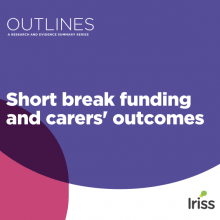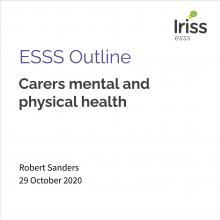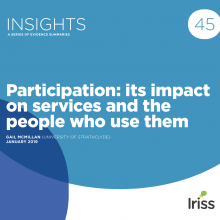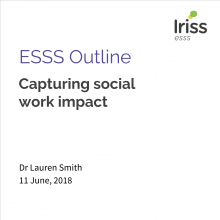This Insight looks at the benefits of telecare to support unpaid carers.
Key points
- Unpaid carers are the largest group of care providers in Scotland.
- Although carers often feel positive about their role, the demands of caring can have an adverse impact on carers' health and well-being.
- Telecare offers an effective means of supporting carers in their caring role, freeing them from unnecessary stress and providing them with greater personal freedom.
- For telecare to benefit more carers, new ways of identifying carers whose situation could benefit from telecare need to be developed.
- More needs to done to be raise awareness of telecare and its benefits among professionals and carers, as well as the general population.
- Telecare needs to be embedded within standard approaches to assessment, care management and review.
- Carers' input into telecare service design and delivery is necessary to ensure that outcomes for carers (and those cared for) are maximised and sustained.
- Staff and carers should be aware of the need for joint working where community based services (telecare) overlap with acute services (telehealth).
Scotland's unpaid carers
The number of people in Scotland who describe themselves as carers is substantial. In 2008 a statistical profile found that there were approximately 660,000 unpaid carers (Scottish Government, 2010), a number expected to grow to one million by 2037 (Carers UK, 2001). At present, more than half of Scotland's carers are people aged 16-40 years and the majority are women. The time they devote to their caring role varies enormously. According to recent research, 63% of carers care for up to 19 hours a week, with 13% of carers caring 20-49 hours per week, and almost a quarter (24%) caring for over 50 hours per week (Scottish Government, 2010).
Although those caring for frail, ill, disabled or older people can benefit from the caring contribution they make, research indicates that the demands of caring can also be onerous and can have an adverse impact on carers' health and wellbeing. According to a recent report, carers who care for 20 or more hours per week were found more likely than other people to be in poor health, have no formal qualifications, share the same household as a person living with long term illness and have no paid employment (Jarrod and Yeandle, 2010).
The contribution that carers make to society in supporting friends and relatives is considerable. Scotland's unpaid carers care for almost one million people living with long term illness and, according to one estimate, save the nation's health and social care system around £7.7 billion per year (Jarrod and Yeandle, 2010). As the population of older people continues to grow and as fiscal pressures increasingly constrain what can be offered through paid services, it seems certain that unpaid care will continue to be the mainstay of the social care system. For this reason, it is critical that we address issues of how to support and sustain carers in their caring role.
Telecare in Scotland: policy background
Telecare has been identified as a key driver in support of unpaid carers in Scotland, a fact reflected in policy and in significant government investment. Although subject to various definitions, 'telecare' has been defined by the Scottish Government as:
"...the remote or enhanced delivery of health and social services to people in their own home by means of telecommunications and computerised systems. Telecare usually refers to equipment and detectors that provide continuous, automatic and remote monitoring of care needs, emergencies and lifestyle changes, using information and communication technology to trigger human responses or shut down equipment to prevent hazards"
(Beale et al, 2009 p2).
In recent years the Scottish Government has looked to increase the development and use of telecare services throughout the country. In its 2005 report The Future of Unpaid Care in Scotland, the government highlighted the significant potential of telecare in supporting carers. It did so by explicitly calling for the role of telecare to be enshrined within policy and services for unpaid carers. In August 2006, the national Telecare Development Programme (TDP) was launched - a four year programme and £16 million investment aimed at developing telecare services within all 32 health and social care partnerships in Scotland. The TDP's overarching objective was to enable more people to live at home for longer by making telecare an integral part of community care services.
The Scottish Government's investment and commitment to telecare was further demonstrated in June 2008 with the launch of the Scottish Telecare strategy Seizing the Opportunity (Joint Improvement Team, 2008) This strategy outlined the TDP's broad objectives for 2008-2010 and suggested how telecare might assist in addressing future care challenges. Telecare's role in supporting carers to continue caring was identified as an important component of this and became the central issue for the 2010 report, A Weight Off My Mind, commissioned by Carers Scotland and supported with funding from the Scottish Government's Joint Improvement Team. The research for the report was undertaken by Professor Sue Yeandle and Kara Jarrad of the Centre for International Research on Care, Labour and Equalities (CIRCLE) at the University of Leeds. The Government's most recent policy for carers, Caring Together: The Carers Strategy for Scotland 2010 -15, has taken up many of the recommendations listed in the University of Leeds report, all of which seek to extend the use and impact of telecare throughout Scotland.
Telecare and carers: the evidence
Evidence relating to telecare has tended to focus on the perspectives of people who use services and on the costs and benefits of telecare for the wider health and social care system. In sharp contrast, little has been written about carers' experiences of telecare. The 2010 University of Leeds study mentioned above has addressed this important research gap. The study sought explicitly to 'illuminate carers' experiences of and understandings about telecare, and to explore the impact that telecare can have for a range of carers in Scotland' (Jarrod and Yeandle, 2010 p15). Much of the evidence provided in this summary comes directly from the findings of that study.
Telecare's Impact on Carers
The 2010 University of Leeds study revealed that carers experienced many positive impacts of telecare. The most beneficial impact cited was that it 'offered the carer 'peace of mind' about the well-being and safety of the person they cared for' (Jarrod and Yeandle, 2010 p27). Since having telecare equipment installed, most reported feeling better supported in their caring role and therefore less anxious and less tired. Although none of the carers in the study reported any direct health benefits arising from the installation of telecare equipment, we can assume that reductions in stress and fatigue were likely to contribute to their overall health and well-being. Carers' high degree of confidence in the reliability of the equipment and telecare support services contributed to their feelings of being better supported. Many said that they felt sure that they would be alerted if an emergency arose, a fact that brought them not only peace of mind, but also a greater sense of personal freedom. Some noted that they benefited from uninterrupted sleep and the opportunity to relax, while others spoke of how telecare had enabled them to spend time on their own interests and hobbies. One explained: 'It has allowed me to do more things at home, like crafts and reading a book. Before I would have to be constantly aware of my husband, it really invaded my own time' (Jarrod and Yeandle, 2010 p17). Such lifestyle benefits were noted by all carers, but were particularly welcomed by those who lived in a different household from the person they cared for.
For some carers, telecare's potential to bring personal freedom translated into an opportunity to participate in paid employment. Several noted that telecare had directly enabled them to return to work and to contribute to the family's financial stability. For those already in paid employment, telecare's benefits were described in terms of allowing individuals to engage more fully in their work activities and to be released from a sense of always being 'on-call' while at work. For still others, the service meant being able to remain in a job they might otherwise have had to give up. One carer said: 'Telecare has enabled me to maintain the hours that I work. It is difficult to get care workers who can cope with the level of care that my husband requires' (Jarrod and Yeandle, 2010 p28). In addition to examining the direct impact that telecare had made on carers' lives, the study also sought to highlight what impact the service had made to individuals' caring roles and their relationship with those they care for. In doing so, it revealed that most carers viewed telecare as complementing their caring role, rather than reducing or replacing that role. Perceptions of telecare as dehumanizing or replacing carer roles (Perry et al, 2010) were challenged by the majority of carers who spoke of telecare's ability to make caring more manageable: 'My caring role is the same, but it's just easier and more manageable now. It is not a replacement for a carer, but it does replace the running up and down I had to do, to constantly check he was all right' (Jarrod and Yeandle, 2010 p31).
The key benefit of telecare was therefore shown to lie in making caring less stressful, rather than in simply reducing or replacing care activities. Most carers spoke of how the majority of care tasks could not be replaced by technology and of how they did not wish for them to be - a fact subsequently highlighted by carers' admissions that telecare brought little reduction in the time they spent caring. These findings are supported by the 2008 evaluation of the Telecare Development Programme which revealed telecare had reduced stress for 74% of carers, but made little difference in terms of time spent caring (Beale et al, 2009).
The ability of telecare to reduce the stress of caring was revealed to have a positive impact on the caring relationship. Many carers spoke of how everyday interactions improved and of how emotional aspects of their relationships with those cared for were enhanced. One carer noted: '(Our relationship has) majorly improved. It's much less stressful... it's more on an even keel now. My husband feels much less disabled than he did and it relieves the pressure on us as a couple. It's been positive for our relationship' (Yarrod and Yeandle, 2010 p31). This finding is important as it is likely to affect not only individual well-being, but also the sustainability of the role of being a long-term carer.
Challenges and concerns affecting carer outcomes
Although the University of Leeds study revealed that telecare was overwhelming valued by carers, it also revealed a number of challenges that carers face in accessing and using the service. Among these challenges, the study highlighted that many carers were using a limited range of equipment (on average two pieces) that was often outdated. It also revealed that carers frequently lacked information about new developments in telecare and about what other equipment might be available to them. In addition, the study revealed that carers paid different fees and charges for the same type of equipment. Charges for personal pendants, for example, ranged from £5 to £16 per month across different partnerships, while one individual paid nothing for the use of eight pieces of equipment.
The personal challenges faced by carers arguably reflect on the larger, regional challenges impacting on telecare's implementation throughout Scotland. One of the most notable challenges impacting on equity of access to telecare is the fact that its implementation across Scotland has been very uneven. According to Beale et al (2009), significant variations in the number of referrals and installations across the country can be attributed, at least in part, to varying degrees of senior management support for the service. Where support is high, as in West Lothian, significant progress has occurred. Where that support is absent, telecare programmes have languished. Discrepancies in service provision are further compounded by inequities in pricing systems, whereby telecare charges have been found to be largely discretionary and without regulation.
Another key challenge to telecare lies in the resistance both within and between the health and social care systems to the development of integrated services for carers and service users (Newhaven Research, 2010). Several studies have documented resistance to telecare among paid carers who believe that the technology will reduce the demand for their work and potentially threatened their jobs (Yeandle, 2009; Perry et al, 2010). Other studies have highlighted a perceived lack of knowledge and awareness about telecare among health care professionals, which in turn is thought to contribute to low referral rates for telecare services (Beale et al, 2009). These findings are supported by the University of Leeds study which revealed that very few carers were referred to telecare services by health care professionals in general and by GPs in particular.
Lack of professional awareness of telecare and its benefits is related to another pertinent challenge in ensuring telecare is effectively accessed and utilised by carers - the successful identification of carers. The University of Leeds study emphasised the need to provide carer training to professionals, particularly to those in the health care sector, and to ensure that information about telecare and its benefits to carers reach those in positions to arrange support. Recognising the importance of self-identification, the study also recommended that carer organisations and other voluntary agencies be supported in their efforts to promote telecare to carers. Developing sustainable services in telecare will also depend upon a robust knowledge base and confidence amongst health and social care staff and unpaid carers in the application of technologies.
If carer access to telecare services has been subject to challenges, so too has their input into design and delivery. In recent years, both academics and local partnership members have recognised the importance of consulting with people who use services in order to meet enhanced service quality and user outcomes. Carer perspectives and outcomes, however, have largely been ignored by most partnerships in Scotland and few have sought to actively engage carers around issues of telecare service design and delivery. This fact is reflected both at the level of individual carer assessments and at the broader strategic engagement level. In terms of carer assessments, the University of Leeds study revealed that while most people were satisfied with their service, their views and experience of the service were infrequently taken into account as part of formal assessments or reviews. Carer views were also revealed to be assumed rather than directly ascertained in design and delivery decision-making at the local level. The study showed that carer engagement into all aspects of service design and delivery was low throughout Scotland.
Implications for policy and practice: conclusions and recommendations
Telecare has been shown to significantly benefit not only people who use services but also their carers, bringing them peace of mind, less stress and greater opportunities to take a break from caring and to gain or retain paid employment. That telecare is able to support carers in their caring role means that it also enables financial and human resources to be deployed elsewhere, offering a win-win response to society's growing care demands (Yeandle, 2009). But recent research also makes it clear that telecare has not yet been adequately mainstreamed or exploited in the way that was envisioned in 2006 (Newhaven Research, 2010). To ensure that the benefits of telecare for carers are maximised to full potential, the University of Leeds study suggests that the following actions be undertaken.
- Steps need to be taken to raise the general awareness of telecare amongst carers in Scotland. Supporting carers' organisations to promote telecare is one such step.
- More needs to be done to raise awareness of telecare and its benefits for carers among health and social services staff and employers. GPs, social workers and human resource professionals should be targeted to ensure help gets to carers at the appropriate time. The toolkit 'A Life of Normality' has been developed by Carers Scotland and the Joint Improvement Team to support this aim. For more information, go to: http://www.carerscotland.org/Policyandpractice/CarersandTelehealthcaretrainingtoolkit
New ways of identifying carers need to be identified across the health and social care system. The Caring Together strategy has committed to identify measures to facilitate this process. - Charges for telecare need to be reviewed and made more equitable.
- Carers' organisations and other voluntary agencies should be supported to promote telecare to carers.
- Telecare should be an integral part of community care and carer assessments. The option of telecare should be integrated into assessment protocols.
- Carers should be engaged regarding the design and delivery of telecare to ensure that they receive the best support possible.The Caring Together strategy calls for carers to be represented on Community Health Partnerships as a means to become involved in the planning, shaping and delivery of services.
Addressing both the practical concerns of individuals and the larger, regional challenges impacting on telecare implementation is vital to ensuring better outcomes for carers. In order to do this effectively, Scotland should continue to invest both financially and politically to ensure that telecare is established as a mainstream component of Scotland's health and social services system. Areas of overlap with services provided by the acute sector using telehealth technologies should be explored and developed. Only by fully embedding telecare into wider systems of care and support will issues of fairness and responsiveness be adequately resolved. Involving carers in service design and delivery will also be a key to ensuring that carers get the support they need to participate fully in Scottish society, free from unnecessary stress.
References
- Beale S, Sanderson D and Kruger J (2009)
- Evaluation of the Telecare Development Programme: final report, Glasgow: Scottish Government. This research is available at: www.carerscotland.org/policyandpractice/ Research
- Carers UK (2001) It could be you: a report on the chances of becoming a carer, London: Carers UK
- Jarrod K and Yeandle S (2010) A Weight off My Mind: Exploring the impact and potential benefits of telecare for unpaid carers in Scotland, Leeds: University of Leeds and Carers Scotland
- Joint Improvement Team (2008) Seizing the Opportunity: Scottish telecare strategy 2008-2010, Edinburgh: Scottish Government
- Newhaven Research (2010) An Assessment of the development of telecare in Scotland 2006-2010, Edinburgh: Joint Improvement Team, Scottish Government.
- Perry J, Beyer S, Francis J and Holmes P (2010) Ethical issues in the use of telecare, London: Social Care Institute for Excellence
- Scottish Government (2010) Caring Together: The Carers Strategy for Scotland 2010-2015, Edinburgh: Scottish Government
- Yeandle S (2009) Telecare: a crucial opportunity to help save our health and social care system, London: Bow Group and the University of Leeds
Thanks
Iriss gratefully acknowledges Carers Scotland and the Joint Improvement Team for facilitating access to telecare research and for providing comment on this Insight.




